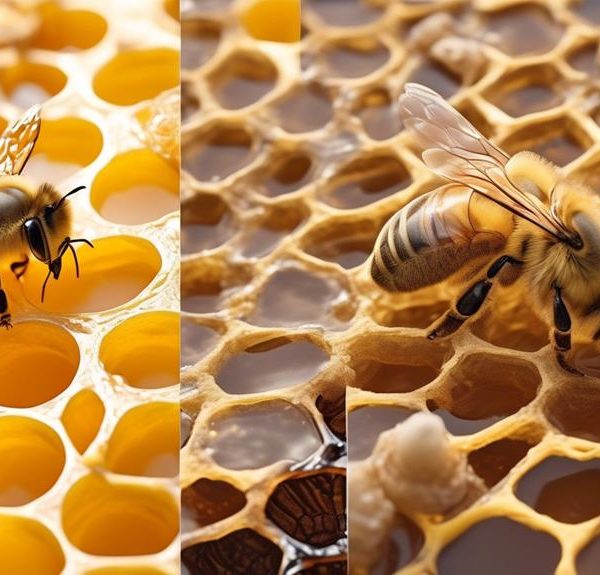Find out if bees, like moths, are drawn to light in this fascinating exploration of insect behavior and biology.
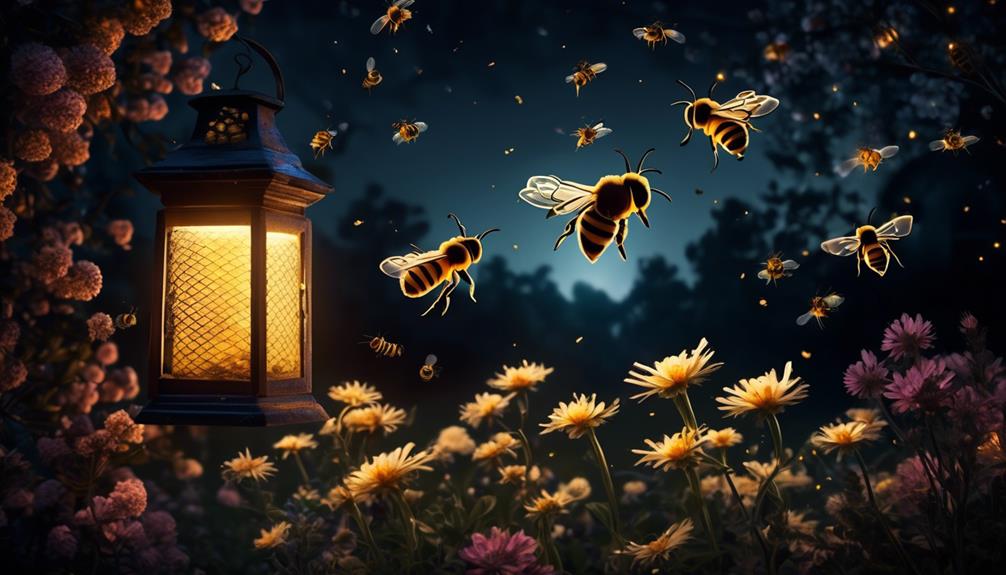
Do Bees Get Attracted to Light?
Imagine you're sitting outside on a warm summer evening, the darkness punctuated only by the gentle glow of the porch light.
Suddenly, a bee zips by, seemingly drawn to the light. Now, you've likely heard about moths being attracted to light, but what about bees? Does the soft glow lure them in as well?
While this may seem like a simple question, the answer is anything but. It's a complex dance of biology and behavior that we're about to explore, one that will challenge your assumptions and may even alter your perception of these buzzing creatures.
Are you intrigued? You should be. Let's take a closer look, shall we?
Key Takeaways
- Bees rely on visual cues, particularly color and light, for their daily activities and navigation.
- Bees are attracted to artificial light sources due to their brightness and multiple wavelengths.
- Prolonged exposure to artificial light can disrupt bees' natural behaviors and negatively impact their health and survival.
- Artificial light at night can confuse bees' internal clocks and disrupt their foraging and navigation behaviors.
Understanding Bee Behavior
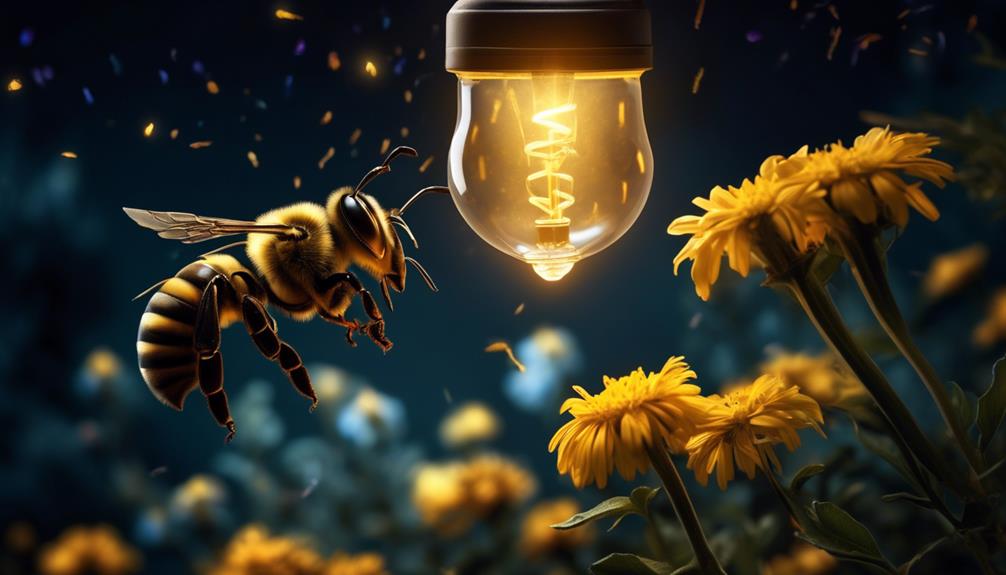
To comprehend why bees may be drawn to light, one must first delve into their behavioral patterns and instincts. Bees, like many insects, are diurnal creatures, meaning they're most active during the day. They're largely guided by visual cues, particularly color and light. This is because they're pollinators and rely on flowers' visual signals for survival.
In addition, bees have an innate navigation system that relies on the sun's position. They're able to calculate the angle and direction of sunlight, even on a cloudy day. This phototactic behavior (movement in response to light) may be a major reason why they're drawn to artificial light sources when the sun isn't available.
Yet, it's not that simple. Bees' attraction to light also depends on the type and intensity of the light. They're more drawn to ultraviolet light, which is abundant in sunlight but less common in artificial lighting. Furthermore, they perceive light differently than humans do, seeing a broader spectrum that includes ultraviolet.
The Science of Phototaxis
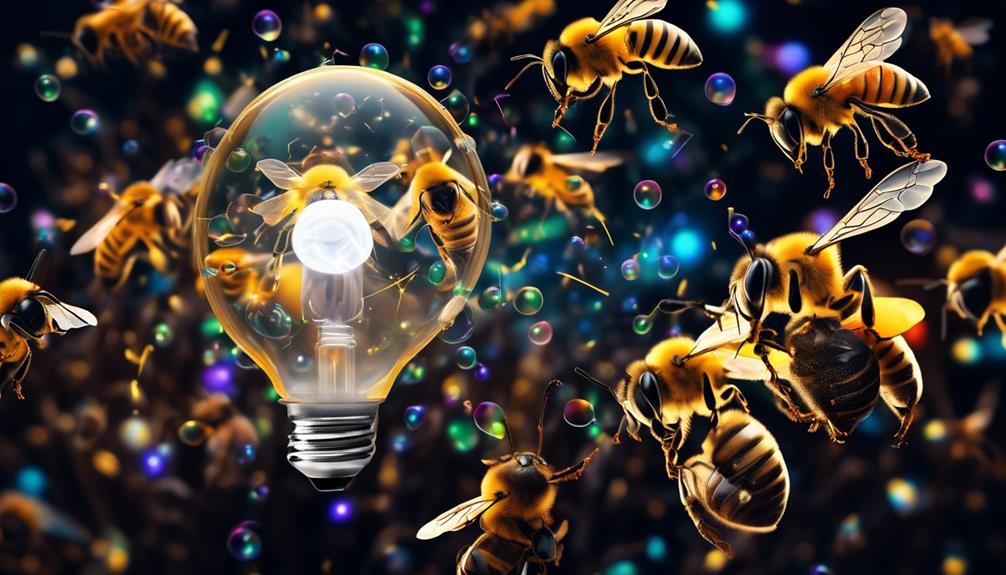
Delving into the science of phototaxis, you'll find it's fascinating how bees, among other insects, exhibit this behavioral response to light, particularly ultraviolet light, which plays a vital role in their daily activities and survival strategies. They aren't only attracted to light in the natural environment, but also to artificial light sources, such as street lamps or your porch light.
Phototaxis is a reaction that determines the movement of an organism in response to light stimulus. For bees, this is an innate behavior. The light they respond to isn't simply what you or I perceive, but extends into the ultraviolet spectrum. This is because flowers, their primary food source, often reflect large amounts of UV light. This ability to detect UV light aids in their foraging activities, making them efficient pollinators.
But why artificial light sources? Well, they're typically brighter and emit light at multiple wavelengths, including ultraviolet. This overwhelms the bee's phototactic response, leading them to these sources. However, prolonged exposure to artificial light can disrupt their natural behaviors, resulting in negative impacts on their health and survival.
Bees' Relationship With Light
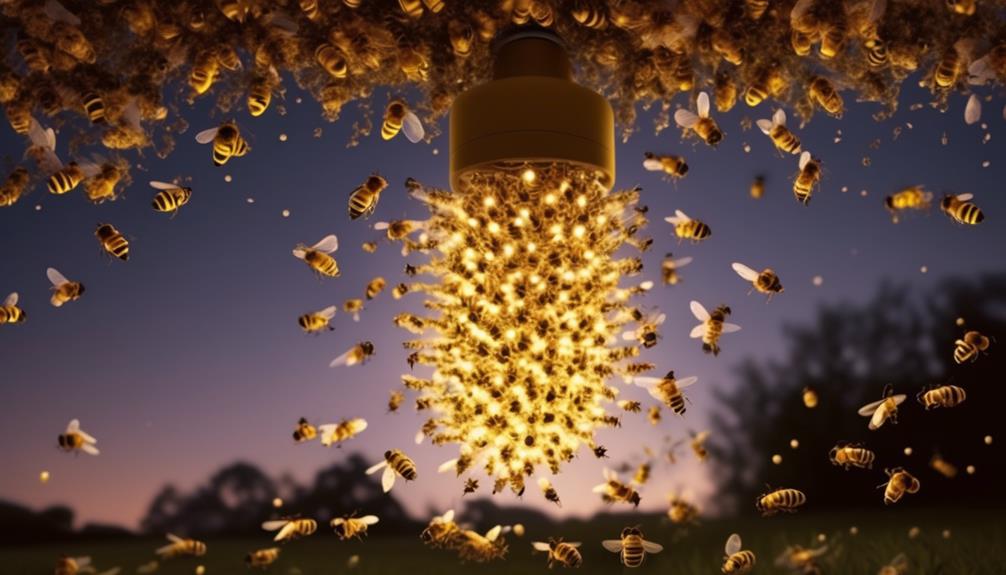
Understanding the role of light in bees' lives, particularly the way they perceive and respond to it, is key to grasping the complex relationship these insects share with both natural and artificial light.
Bees, like many insects, have photoreceptors that enable them to detect varying spectrums of light. In fact, their vision is most sensitive to ultraviolet light, a spectrum beyond human perception. This sensitivity equips them with an extraordinary ability to perceive flower patterns and navigate using the sun.
However, bees' reaction to light isn't always beneficial. Artificial light, particularly at night, can disrupt their natural behaviors. Bees are diurnal creatures, meaning they're active during the day and rest at night. Exposure to artificial light during dark hours can confuse their internal clocks, leading to disoriented flight patterns and decreased pollination efficiency.
Moreover, while bees aren't traditionally considered phototactic (light-seeking), studies show evidence of bees being attracted to certain types of artificial light, likely due to its resemblance to sunlit paths. This tendency can result in fatal attraction, as bees end up exhausting themselves or falling prey to predators.
Therefore, understanding bees' relationship with light is crucial for their conservation.
Comparing Bees to Other Insects
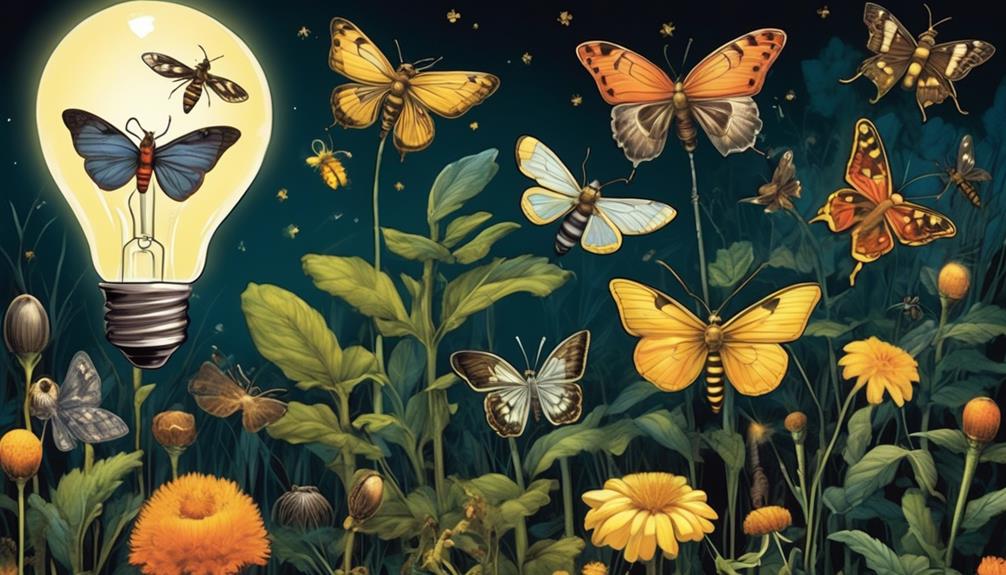
While bees exhibit a complex relationship with light, it's interesting to compare their behaviors with other insects to gain a broader understanding of light's impact on the insect world. Unlike bees, many insects, such as moths and beetles, are positively phototactic, meaning they're instinctively drawn to light sources. This behavior often leads to their entrapment in artificial light sources, which you may have observed on summer nights.
On the other hand, bees aren't as strongly attracted to light. They're primarily diurnal creatures, active during the day, and their vision is more sensitive to ultraviolet light, which helps them locate flowers. Artificial light doesn't usually have the same allure for them as it does for other insects. However, research has shown that bees can become disoriented when exposed to artificial light at night, disrupting their navigation and foraging behaviors.
In contrast, other insects like cockroaches are negatively phototactic, actively avoiding light sources, which is why they're typically seen scuttling away when you switch on a light.
In short, the relationship between insects and light is varied and complex, with different species exhibiting distinct behaviors. Understanding these differences can help in the development of strategies for managing and protecting these vital creatures.
Impact of Artificial Light on Bees
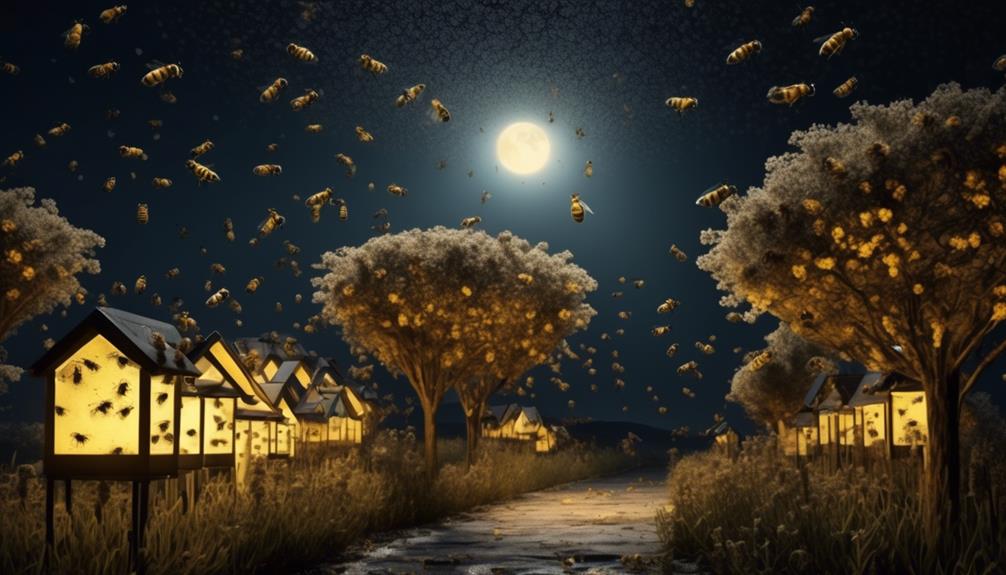
Artificial light's influence on bees has been a topic of interest, as it often interferes with their natural behaviors, leading to disorientation and disrupted foraging patterns. This light pollution, mainly from streetlights and residential lighting, can greatly affect bees' navigation systems. It's disrupting their ability to find food and return to their hives, a crucial process in pollination.
Research shows that bees exposed to artificial light exhibit changes in their behavior. They're active for longer periods and start foraging earlier in the day, depleting their energy reserves faster. They're also less likely to return to the hive, which can lead to population decline.
Moreover, artificial light affects bees' internal clocks, leading to a mismatch in their foraging activities with the availability of flowers. It's causing a ripple effect, disturbing the balance in local ecosystems.
It's crucial that you understand this issue, as bees play a vital role in our ecosystem. By reducing unnecessary lighting and using light shields, we can help minimize the impact of artificial light on bees. Remember, a decline in bee populations doesn't just affect them, it affects us and the world's food supply.
Frequently Asked Questions
How Can I Safely Remove Bees Attracted to the Lights in My Home?
To safely remove bees drawn to your home's lights, first switch off the lights, as darkness can disorient them.
Then, create a bee-friendly exit by opening a window.
If they're stubborn, try luring them out with a light outside.
For a long term solution, consider replacing your lights with yellow or sodium vapor bulbs, which bees aren't attracted to.
If all else fails, call a local beekeeper or pest control.
Can Certain Colors of Light Attract or Repel Bees More Than Others?
Yes, bees are indeed attracted to certain colors of light more than others. They're especially drawn to blue and ultraviolet light, which mimic the colors of many flowers.
Conversely, they're less attracted to red light because they can't see it well.
How Do Bees' Attraction to Light Compare to Their Attraction to Certain Scents or Flowers?
You're comparing bees' responsiveness to light with their reaction to certain scents or flowers.
Bees don't primarily orient themselves by light. Instead, they're attracted to flower colors and scents. They can detect ultraviolet light, which many flowers reflect.
However, their primary navigation method is scent. They've got an extraordinary sense of smell, which they use to locate flowers.
They're particularly attracted to sweet, fruity, and fresh floral scents.
What Are Some Effective Ways to Deter Bees From Being Attracted to My Outdoor Lights?
If you're looking to deter bees from your outdoor lights, there are a few methods you can try.
Bees aren't typically attracted to light, but if you're noticing an increase, consider switching to yellow or sodium vapor bulbs.
Alternatively, you can install covers over your lights or use dimmer bulbs.
If they're still a nuisance, it's best to turn off your lights when not in use.
Can the Attraction to Light Impact the Bee's Ability to Pollinate Effectively?
Yes, attraction to light can impact a bee's pollination efficiency. If you're noticing a lot of bees around your lights, they're probably getting disoriented and wasting energy. This can affect their ability to find and collect nectar.
Instead of focusing on pollination, they're being drawn to your lights. This not only reduces their productivity, but can also disrupt the natural balance of your local ecosystem.
Conclusion
So, you've learned that unlike many insects, bees aren't drawn to light due to their unique relationship with phototaxis. It's fascinating, isn't it?
However, artificial light can disrupt their behavior and natural activity.
This comparison between bees and other insects sheds light on the diversity of nature.
Remember, understanding these small creatures contributes to our broader knowledge of the ecosystem, helping us make more informed decisions about our environment.

